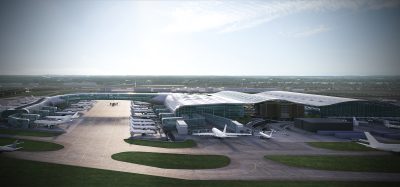Relieving NYC’s congested airspace
Posted: 4 April 2013 | Ann Crook, Director of Aviation, Elmira Corning Regional Airport and President of the New York Aviation Management Association | No comments yet
Ann Crook, Director of Aviation at Elmira Corning Regional Airport and President of the New York Aviation Management Association, discusses how efforts are being made to lessen and control the crowded airspace above New York City.
Airports in New York’s Upstate and Western regions have particular concerns about the impacts of congestion in the New York City airspace. The New York Aviation Management Association (NYAMA) has been following efforts to manage the congested airspace and reduce associated delays. From the vantage point of both inside and outside one of the world’s most congested aviation systems, NYAMA has been a supporter of the NextGen initiative.
Ann Crook, Director of Aviation at Elmira Corning Regional Airport and President of the New York Aviation Management Association, discusses how efforts are being made to lessen and control the crowded airspace above New York City.
Airports in New York’s Upstate and Western regions have particular concerns about the impacts of congestion in the New York City airspace. The New York Aviation Management Association (NYAMA) has been following efforts to manage the congested airspace and reduce associated delays. From the vantage point of both inside and outside one of the world’s most congested aviation systems, NYAMA has been a supporter of the NextGen initiative.
Airspace congestion in the New York City (NYC) area is a well-documented area of concern for the aviation system, both in the U.S. and internationally. Airspace delays cost the U.S. economy as much as $41 billion in 2007, according to a study by the U.S. Senate’s Joint Economic Committee. In addition to the wasted dollars, delays resulted in an additional 740 million gallons of jet fuel burned and 4.3 million wasted hours. These numbers are staggering and the three NYC area airports – John F. Kennedy International Airport (JFK), Newark Liberty International Airport (EWR), and LaGuardia Airport (LGA) – account for the bulk of these delays.
Congestion in NYC airspace results in delays throughout the north east region and worldwide. Due to aircraft utilisation throughout carriers’ systems, delays originating in NYC can have a ripple effect, leading to delays even in areas with no congestion. Because of the extreme cost and the widespread negative impacts to air travel, managing the congestion in the NYC area to reduce delay is a priority for the Federal Aviation Administration (FAA) as well as for the Port Authority of New York & New Jersey (PANY&NJ).
In general terms there are two ways to mitigate airspace congestion: adding capacity and reducing demand. Capacity can be added through infrastructure improvements and more efficient management of airspace. PANY&NJ has been aggressively making infrastructure enhancements to improve throughput. Adding high-speed exit taxiways and taxiway connectors, creating more efficient taxi routes, and adding parking gates are examples of construction activity aimed at increasing capacity. But these types of improvements can only go so far. Land constraints in the area limit the physical ability to expand.
PANY&NJ has also looked to add capacity by adding to its airport system. In 2007, PANY&NJ purchased the operating lease of Stewart International Airport (SWF) in the Hudson Valley. The hope is that by bringing SWF into the portfolio of airports operated by PANY&NJ, some demand could be moved away from JFK, EWR, and LGA. PANY&NJ has made infrastructure improvements to SWF and aggressively sought scheduled air service in an effort to do this. There have been successes in these efforts, but with annual enplanements in the ballpark of 200,000 passengers, as compared to JFK’s 12 million, the impact of SWF as a tool to reduce the combined demand of the NYC airports and thereby relieve congestion is limited.
Regulatory/operational methods to reduce demand have also been used. The FAA manages Operating Authorisations or ‘slots’ for landings and departures at JFK, LGA, and EWR. These slots are hard limits on the number of aircraft operations allowed at these airports; they are a regulatory means to cap the demand on the airspace. NYAMA first became actively engaged in the methods of managing the NYC airspace in 2008 when the FAA proposed ‘slot auctions’ for slots at EWR. The proposal would have allowed air carriers to make monetary lease bids on available slots. The philosophy behind this action is that by placing a dollar value on the slots carriers would use the slots in a way that minimises the net cost per operation. By utilising the largest aircraft equipment the cost of the slot would be spread among the maximum number of passengers. In this way the ‘cost’ of providing airspace gets allocated among passengers.
While this method appears to make sense, it disregards carriers’ management of the way they serve various markets and creates significant barriers to smaller air service markets. In the FAA’s evaluation of the slot auction proposal they specifically concluded that operations flown with very small aircraft have little value and would be replaced with large aircraft operations serving larger, more distant cities. This proposal to mitigate airspace congestion took direct aim at smaller, closer air service markets, specifically those between the NYC airports and Upstate and Western New York communities. This stark judgment that access to our State’s financial centre is of little value served as a call to action for New York’s airport managers.
Small and non-hub airports across the U.S. are concerned with the ability to access the NYC airports because of the usefulness of those large hubs and the access to the financial market-related industry in New York City. These access concerns are even more significant for Upstate New York communities which have these same transportation needs but are also linked to NYC by state connections. Upstate New York businesses often work with corporate offices, governmental regulators, and other business relationships which are within the State. To put it more succinctly, a federal policy that makes it easier for West Coast travellers to get to New York City than Upstate travellers to get to their own corporate offices in New York City is an unfair disadvantage for New York’s smaller communities.
NYAMA strongly opposed the sale of slots in an effort to preserve air access to the NYC airports for our smaller airport members. But we do recognise that the increasing congestion still creates a barrier to service, even without the slot sales. The existing level of delay makes it very difficult for regional air carrier service between small and non-hubs and the NYC airports to be successful. Increased operating costs associated with delay are a barrier to these very priceelastic markets. Lack of reliability is another barrier in small markets which offer limited frequency. In order to truly make the NYC airports accessible, the airspace itself must become much for efficient.
NextGen – the FAA’s Next Generation Air Transportation System, which plans to use modern, current technology in all phases of aircraft operations to achieve system efficiencies – offers possible solutions to the NYC airspace congestion problem. PANY&NJ has already begun the transition to NextGen by installing Airport Surface Detection Equipment – Model X (ASDE-X). This satellitebased system tracks the actual location and speed of aircraft on the ground, allowing for more efficient taxi routes and taxi traffic management.
NextGen will also offer satellite-based technologies to increase the efficiency of departures and arrivals in congested airspace. Performance-based navigation such as Required Navigation Performance or RNP approaches will allow aircraft to fly point-topoint in the most direct path, while closely monitoring terrain, obstructions, and other moving aircraft. This technology is essential to the safe and efficient operation of the NYC airspace where thousands of aircraft movements occur at several airports in the same area every day.
Ultimately the various satellite-based technologies known as NextGen will increase throughput by allowing the simultaneous use of parallel runways, even during instrument meteorological conditions; safely compressing aircraft separation on both arrivals and departures, more efficiently sequencing complex aircraft mixes for approaches, and providing better situational awareness to flight crews, controllers, and dispatchers through all phases of flight. By combining all of the technologies and benefits it is expected that significant capacity enhancements can be gained in metroplexes such as NYC.
In addition to more efficient management of our congested airspace, there are some other very important benefits to be gained from full implementation of NextGen. By flying point-to-point routes carriers can dramatically cut fuel usage which has major implications to carrier profitability. Reductions in fuel usage also reduce air pollution and cut reliance on fossil-fuels. Direct routing will reduce the size of noise footprints. And continuous descent approaches significantly reduce the loud power settings required to fly traditional approaches which are often over residential or other noise-sensitive neighbourhoods.
Good access to the national airspace system is critical for economic development and even economic viability in smaller and rural communities. Some barriers to this access include the high cost of aircraft operation associated with fuel costs and the delays and schedule unreliability associated with congestion at some airports.
Making significant reductions to airspace congestion is a matter of national significance, not just for the metroplexes, but for smaller communities as well. The NextGen suite of projects aimed at moving our national airspace system away from 60-year-old ground-based technologies to modern satellite-based technologies is a comprehensive approach that can provide these crucial enhancements. Airports, air carriers, business aircraft operators, and others are reliant on the FAA to provide the navigational aids and air traffic control equipment that make up the infrastructure or our airspace system. Smaller communities like Elmira in Upstate New York and across America need the FAA to be aggressive in implementing the Next Generation Air Transportation System.
Biography
Ann Crook is the Director of Aviation at Elmira Corning Regional Airport where she is working to increase and improve commercial air service, attract aviation-related commercial and industrial activity, and to integrate the airport facility into her Upstate New York community. Ann also serves as the President of the New York Aviation Management Association.
In 2000 Ann was appointed by the Governor as the first Director of the new Oregon Department of Aviation. An accredited airport executive, Ann has been the Operations Manager at the Eugene Airport in Oregon, Manager of the Hutchinson Airport in Kansas, Manager of the State of Oregon’s 36 airports, and Director of the Klamath Falls Airport in Oregon. From 2005-2007 Ann served as Chair of the Northwest Regional Air Service Initiative which sought innovative air service solutions throughout Washington, Oregon, and Idaho. Additionally, she has worked for several small air carriers in Alaska, during this time her duties included flight attending on DC-3s and F-27s.
Ann holds a Bachelor of Science degree in Aeronautical Management, from Embry-Riddle Aeronautical University in Prescott, Arizona.
The International Airport Summit is open for registration!
Date: 19 – 20 November 2025
Location: JW Marriott Hotel Berlin
At our flagship event of the year, we will dive into the future of airport operations, with expert-led sessions on passenger experience, innovative smart technologies, baggage handling, airside operations, data, security, and sustainability.
This is where global airport leaders come together to share insights, challenges, and real-world solutions.
Limited complimentary passes are available for eligible professionals – first come, first served!

















